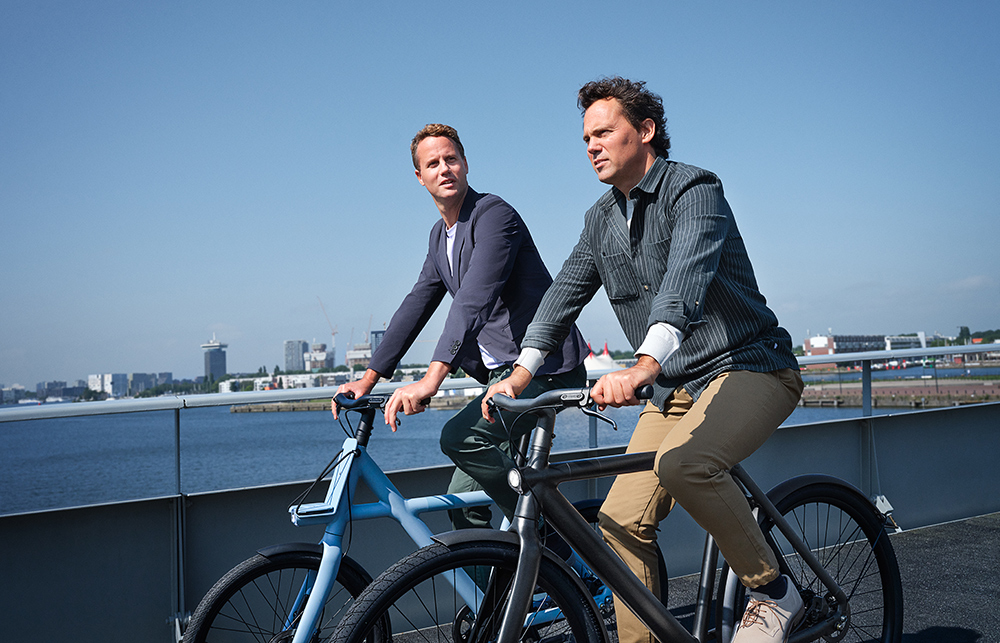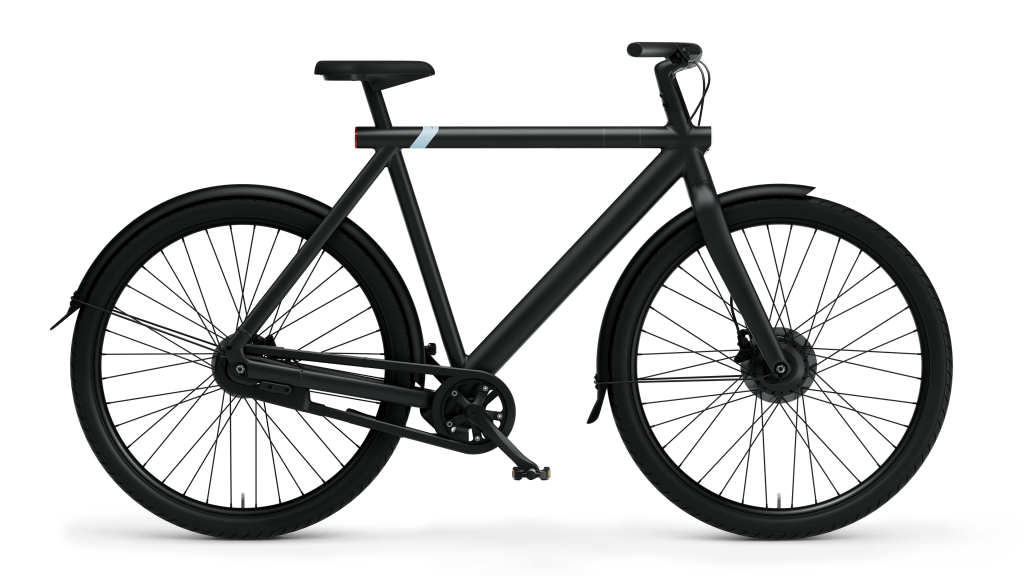
泰斯·卡利尔仍然在重新熟悉荷兰阿姆斯特丹的自行车道,因为他要带领《财富》杂志试骑VanMoof的S3电动自行车。他在中国台湾生活了多年。但是,骑着自行车穿梭在阿姆斯特丹时尚的北部地区,这位荷兰人很快找回了熟悉的感觉。他轻松地在自行车道上骑行,回到了公司附近崭新的总部,并向他的客人展示了S3电动自行车的功能。
在台北基地视察研发设施后,卡利尔暂时回到了荷兰。他对一件事情的印象非常深刻,那就是目前在荷兰首都街道上行驶的VanMoof自行车数量惊人。他和他的兄弟塔科·卡利尔在2009年共同创办了电动自行车品牌VanMoof,并大获成功,他们正努力在纽约、巴黎、柏林和东京等全球主要城市复制自己的成功之路,并且,他们还得到了一些重量级风险资本家的支持。他们和他们的投资者在人们通勤方式的转变中看到了商机,这种转变反映了人们对拥堵和污染问题的日益关注,而长期以来一直致力于满足汽车需求的大城市正在大力建设有利于自行车的基础设施。
“这只是变革的开始,我相信在10到20年内,我们将在纽约、旧金山、巴黎、伦敦和东京的街道上看到与阿姆斯特丹一样多的自行车。”塔科在接受《财富》杂志采访时说。
VanMoof认为,电动自行车将成为自行车热潮的重要组成部分。不可否认,经过多年的缓慢增长,电动自行车已经成为自行车市场的主流产品。在全球范围内,电动自行车市场的规模估计约为250亿美元,预计到本十年末,这一数字将翻一番。在荷兰,电动自行车占了所有新自行车销售的50%。美国市场仍然很小,是VanMoof及其众多竞争对手抢占的主要市场。NPD集团(NPD Group)表示,2021年前4个月,电动自行车销量增长了一倍多,达到6.81亿美元。VanMoof的全球销售额在2020年增长了两倍,但该公司不愿意透露具体数据。
光明的前景为该行业吸引了大量的风险资本。VanMoof的时尚设计和防盗技术吸引了众多支持者,继一年前的4000万美元融资后,VanMoof在今年8月融资1.28亿美元。它的竞争对手Rad Power在今年的两轮融资中筹集了3.04亿美元。显然,这已经成为了电动自行车行业的一场军备竞赛。事实上,根据PitchBook的数据,自2017年年初以来,风投已经向电动自行车公司投入了32亿美元。
新冠疫情让更多的人倾向于骑电动自行车或传统自行车作为消遣。这也让许多人意识到,它们可以代替拥挤的公共交通或汽车,成为一种可行的通勤方式。NPD集团的高级行业顾问马特·鲍威尔表示:“我们看到,人们购买电动自行车是为了代替汽车,而不是自行车。”
泰斯说,对于居住在距离办公室3至9英里(5至15公里)之间的人,VanMoof是他们的最佳选择。这段距离不长,人们能够骑自行车而不是开车或乘坐公共交通工具,但也足以让使人出汗,尤其是在像纽约这样的城市的夏天。
VanMoof的名字取自英文单词“move”,但实际上在荷兰语中发音与“loaf”押韵。该公司于2016年以传统自行车为基础推出电动自行车,迄今已经售出了20万辆电动自行车。卡利尔兄弟认为,随着电动自行车的蓬勃发展,在几年内,其电动自行车在欧洲、美国和日本的销售量有望达到1000万辆。VanMoof自行车在美国的售价为2300美元,比普通自行车贵,但肯定比汽车便宜得多。
"这就是你需要电动自行车的原因,它更快、更有趣,而且更便宜。"泰斯说。当然,他们的诀窍是让消费者选择VanMoof。
效仿苹果和特斯拉
卡利尔兄弟都在南荷兰的代尔夫特理工大学(Delft University of Technology)学习工业设计,他们说,创立VanMoof之前,在纽约市的一次旅行中让他们萌生了创建公司的想法。他们发现,骑自行车是游览纽约的最佳方式,但令人惊讶的是,由于当时纽约市的自行车基础设施还不完善,因此很少有人骑自行车。“我们很惊讶,骑自行车游览是如此完美,但却很少有人这样做。”43岁的塔科说,他比泰斯大一岁。他们正确地预测,像纽约和巴黎这样的城市最终会建立起更多的自行车道,并开始驯服根深蒂固的汽车文化。
他们并不是唯一看到机会的人。今天,挑战者不计其数:从传统的自行车制造商,例如崔克(Trek)和捷安特(Giant),到摩托车制造商哈雷戴维森(Harley Davidson),再到RadPower这样的后起之秀,都想在电动自行车市场分一杯羹。
虽然VanMoof自行车以其简洁的线条和圆滑的外观而著称,但其中一些功能是设计而非美学的结果。泰斯说,比如,直接内置在横梁中的前灯是为了避免电缆伸出并在繁忙的自行车停车位(例如阿姆斯特丹的停车位)中被卡住。
VanMoof电动自行车是智能化的自行车,这让它从众多竞争对手中脱颖而出。它的一个突出特点是其防盗技术,可以通过智能手机应用程序进行管理,如果自行车被盗,用户就能够通过GPS定位,并让VanMoof的“自行车猎人”在主要城市与当地警察合作,找回自行车。用户还可以远程启动警报,并让车灯远程闪烁。如果不通过其应用程序打开,自行车就无法使用。VanMoof公司表示,如果购买了保护计划的客户在两周内无法取回被盗自行车,VanMoof就将为其提供替换服务。在欧洲,95%的被盗自行车都已经被找回。但在北美,由于一些警察部门对追捕自行车窃贼的热情有限,被找回的比例较低。
当被问及VanMoof与竞争对手的不同之处时,泰斯迅速回答道,它控制着零部件,制造商专门为VanMoof生产零部件,并确保它们与VanMoof的技术兼容,类似于苹果公司(Apple)的运作方式。

"We believe that's the best way to create a seamless integration between hardware and software, we copied it from Apple," says Taco.“我们相信这是实现硬件和软件无缝集成的最佳方式,这一点我们效仿了苹果。”塔科说。
卡利尔兄弟认为,用他们自己生产的VanMoof组件来控制供应链对质量控制至关重要,而不是像其他竞争对手一样和不计其数的供应商合作。这对于拥有跟踪自行车健康状况的传感器以确保预测性维护是非常关键的,或者更简单地说,这对于及时发现自行车的小问题是非常关键的。当然,更多的控制权也有弊端:它必须把自己的供应链钉死,因为关键部件的替代品并不容易获得。因此,VanMoof也没有幸免于大多数自行车制造商所面临的长期积压问题:现在订购VanMoof的X3自行车的美国消费者要到仲冬才会收到货。(S3 将在两周内上市。)
兄弟俩说,VanMoof在今年8月赢得的大笔资金将主要用于研发。其中包括寻找更有效的方法来制造更多数量的自行车。在这一点上,他们从硅谷先驱者那里找到了灵感。“埃隆·马斯克几乎在每次采访中都会说,真正的创新在于生产。”泰斯说。(硅谷也正在成为VanMoof的业务来源:许多不愿意透露姓名的大型科技公司正在向员工提供自行车作为福利。)
这笔钱还将用于在关键市场建立更多的VanMoof服务中心,这一点至关重要,因为VanMoof已经决定不通过自行车商店进行大规模销售,而是直接向消费者销售。VanMoof决定把重点放在几个关键的全球门户城市,并以这种方式来打头阵,而不是在大量的城市开设实体店。
塔科说,为了补充自己的支持中心,VanMoof在不同的市场建立了一个自行车专家网络,可以帮助客户解决自行车的问题。(VanMoof也遇到了自行车运送途中出现的划痕和凹痕问题,这是直接面向消费者零售的一些局限性。)
NPD集团的鲍威尔同意这一策略。“这些自行车附带了重要的配套服务。”鲍威尔说。“因此必须有一些基础设施来支持这些服务。”
鉴于竞争对手正在通过自己的商店或与合作伙伴一起建立自己的销售网,建立这种基础设施就更加重要了。举例来说,百思买(Best Buy)在扩张之前,已经开始在Bird、Super73和转运Swft等门店销售产品,还可以雇佣零售商的奇客小分队(Geek Squad)来组装和设置自行车,收费为99.99美元。
虽然他们要做的事情很多,但在看到主要中心城市的人们对更好的自行车基础设施日益增长的需求后,卡利尔兄弟感到振奋不已,其中大部分增长将来自电动自行车。纽约最近在其标志性的布鲁克林大桥上开辟了一条新的自行车道;巴黎已经奇迹般地变得对自行车相当友好,每天有100万巴黎人骑自行车上下班;阿姆斯特丹正在扩建许多自行车道,以适应规模逐渐扩大的自行车交通,其中包括越来越多年轻顾客喜欢的电动自行车。
“现在,在我回来的两个月后,我看到整个阿姆斯特丹20多岁的人们都在骑电动自行车,这是最好和最酷的转变。”泰斯说,因为我们又开始在城市里兜风了。(财富中文网)
译者:Transn
泰斯·卡利尔仍然在重新熟悉荷兰阿姆斯特丹的自行车道,因为他要带领《财富》杂志试骑VanMoof的S3电动自行车。他在中国台湾生活了多年。但是,骑着自行车穿梭在阿姆斯特丹时尚的北部地区,这位荷兰人很快找回了熟悉的感觉。他轻松地在自行车道上骑行,回到了公司附近崭新的总部,并向他的客人展示了S3电动自行车的功能。
在台北基地视察研发设施后,卡利尔暂时回到了荷兰。他对一件事情的印象非常深刻,那就是目前在荷兰首都街道上行驶的VanMoof自行车数量惊人。他和他的兄弟塔科·卡利尔在2009年共同创办了电动自行车品牌VanMoof,并大获成功,他们正努力在纽约、巴黎、柏林和东京等全球主要城市复制自己的成功之路,并且,他们还得到了一些重量级风险资本家的支持。他们和他们的投资者在人们通勤方式的转变中看到了商机,这种转变反映了人们对拥堵和污染问题的日益关注,而长期以来一直致力于满足汽车需求的大城市正在大力建设有利于自行车的基础设施。
“这只是变革的开始,我相信在10到20年内,我们将在纽约、旧金山、巴黎、伦敦和东京的街道上看到与阿姆斯特丹一样多的自行车。”塔科在接受《财富》杂志采访时说。
VanMoof认为,电动自行车将成为自行车热潮的重要组成部分。不可否认,经过多年的缓慢增长,电动自行车已经成为自行车市场的主流产品。在全球范围内,电动自行车市场的规模估计约为250亿美元,预计到本十年末,这一数字将翻一番。在荷兰,电动自行车占了所有新自行车销售的50%。美国市场仍然很小,是VanMoof及其众多竞争对手抢占的主要市场。NPD集团(NPD Group)表示,2021年前4个月,电动自行车销量增长了一倍多,达到6.81亿美元。VanMoof的全球销售额在2020年增长了两倍,但该公司不愿意透露具体数据。
光明的前景为该行业吸引了大量的风险资本。VanMoof的时尚设计和防盗技术吸引了众多支持者,继一年前的4000万美元融资后,VanMoof在今年8月融资1.28亿美元。它的竞争对手Rad Power在今年的两轮融资中筹集了3.04亿美元。显然,这已经成为了电动自行车行业的一场军备竞赛。事实上,根据PitchBook的数据,自2017年年初以来,风投已经向电动自行车公司投入了32亿美元。
新冠疫情让更多的人倾向于骑电动自行车或传统自行车作为消遣。这也让许多人意识到,它们可以代替拥挤的公共交通或汽车,成为一种可行的通勤方式。NPD集团的高级行业顾问马特·鲍威尔表示:“我们看到,人们购买电动自行车是为了代替汽车,而不是自行车。”
泰斯说,对于居住在距离办公室3至9英里(5至15公里)之间的人,VanMoof是他们的最佳选择。这段距离不长,人们能够骑自行车而不是开车或乘坐公共交通工具,但也足以让使人出汗,尤其是在像纽约这样的城市的夏天。
VanMoof的名字取自英文单词“move”,但实际上在荷兰语中发音与“loaf”押韵。该公司于2016年以传统自行车为基础推出电动自行车,迄今已经售出了20万辆电动自行车。卡利尔兄弟认为,随着电动自行车的蓬勃发展,在几年内,其电动自行车在欧洲、美国和日本的销售量有望达到1000万辆。VanMoof自行车在美国的售价为2300美元,比普通自行车贵,但肯定比汽车便宜得多。
"这就是你需要电动自行车的原因,它更快、更有趣,而且更便宜。"泰斯说。当然,他们的诀窍是让消费者选择VanMoof。
效仿苹果和特斯拉
卡利尔兄弟都在南荷兰的代尔夫特理工大学(Delft University of Technology)学习工业设计,他们说,创立VanMoof之前,在纽约市的一次旅行中让他们萌生了创建公司的想法。他们发现,骑自行车是游览纽约的最佳方式,但令人惊讶的是,由于当时纽约市的自行车基础设施还不完善,因此很少有人骑自行车。“我们很惊讶,骑自行车游览是如此完美,但却很少有人这样做。”43岁的塔科说,他比泰斯大一岁。他们正确地预测,像纽约和巴黎这样的城市最终会建立起更多的自行车道,并开始驯服根深蒂固的汽车文化。
他们并不是唯一看到机会的人。今天,挑战者不计其数:从传统的自行车制造商,例如崔克(Trek)和捷安特(Giant),到摩托车制造商哈雷戴维森(Harley Davidson),再到RadPower这样的后起之秀,都想在电动自行车市场分一杯羹。
虽然VanMoof自行车以其简洁的线条和圆滑的外观而著称,但其中一些功能是设计而非美学的结果。泰斯说,比如,直接内置在横梁中的前灯是为了避免电缆伸出并在繁忙的自行车停车位(例如阿姆斯特丹的停车位)中被卡住。
VanMoof电动自行车是智能化的自行车,这让它从众多竞争对手中脱颖而出。它的一个突出特点是其防盗技术,可以通过智能手机应用程序进行管理,如果自行车被盗,用户就能够通过GPS定位,并让VanMoof的“自行车猎人”在主要城市与当地警察合作,找回自行车。用户还可以远程启动警报,并让车灯远程闪烁。如果不通过其应用程序打开,自行车就无法使用。VanMoof公司表示,如果购买了保护计划的客户在两周内无法取回被盗自行车,VanMoof就将为其提供替换服务。在欧洲,95%的被盗自行车都已经被找回。但在北美,由于一些警察部门对追捕自行车窃贼的热情有限,被找回的比例较低。
当被问及VanMoof与竞争对手的不同之处时,泰斯迅速回答道,它控制着零部件,制造商专门为VanMoof生产零部件,并确保它们与VanMoof的技术兼容,类似于苹果公司(Apple)的运作方式。
"We believe that's the best way to create a seamless integration between hardware and software, we copied it from Apple," says Taco.“我们相信这是实现硬件和软件无缝集成的最佳方式,这一点我们效仿了苹果。”塔科说。
卡利尔兄弟认为,用他们自己生产的VanMoof组件来控制供应链对质量控制至关重要,而不是像其他竞争对手一样和不计其数的供应商合作。这对于拥有跟踪自行车健康状况的传感器以确保预测性维护是非常关键的,或者更简单地说,这对于及时发现自行车的小问题是非常关键的。当然,更多的控制权也有弊端:它必须把自己的供应链钉死,因为关键部件的替代品并不容易获得。因此,VanMoof也没有幸免于大多数自行车制造商所面临的长期积压问题:现在订购VanMoof的X3自行车的美国消费者要到仲冬才会收到货。(S3 将在两周内上市。)
兄弟俩说,VanMoof在今年8月赢得的大笔资金将主要用于研发。其中包括寻找更有效的方法来制造更多数量的自行车。在这一点上,他们从硅谷先驱者那里找到了灵感。“埃隆·马斯克几乎在每次采访中都会说,真正的创新在于生产。”泰斯说。(硅谷也正在成为VanMoof的业务来源:许多不愿意透露姓名的大型科技公司正在向员工提供自行车作为福利。)
这笔钱还将用于在关键市场建立更多的VanMoof服务中心,这一点至关重要,因为VanMoof已经决定不通过自行车商店进行大规模销售,而是直接向消费者销售。VanMoof决定把重点放在几个关键的全球门户城市,并以这种方式来打头阵,而不是在大量的城市开设实体店。
塔科说,为了补充自己的支持中心,VanMoof在不同的市场建立了一个自行车专家网络,可以帮助客户解决自行车的问题。(VanMoof也遇到了自行车运送途中出现的划痕和凹痕问题,这是直接面向消费者零售的一些局限性。)
NPD集团的鲍威尔同意这一策略。“这些自行车附带了重要的配套服务。”鲍威尔说。“因此必须有一些基础设施来支持这些服务。”
鉴于竞争对手正在通过自己的商店或与合作伙伴一起建立自己的销售网,建立这种基础设施就更加重要了。举例来说,百思买(Best Buy)在扩张之前,已经开始在Bird、Super73和转运Swft等门店销售产品,还可以雇佣零售商的奇客小分队(Geek Squad)来组装和设置自行车,收费为99.99美元。
虽然他们要做的事情很多,但在看到主要中心城市的人们对更好的自行车基础设施日益增长的需求后,卡利尔兄弟感到振奋不已,其中大部分增长将来自电动自行车。纽约最近在其标志性的布鲁克林大桥上开辟了一条新的自行车道;巴黎已经奇迹般地变得对自行车相当友好,每天有100万巴黎人骑自行车上下班;阿姆斯特丹正在扩建许多自行车道,以适应规模逐渐扩大的自行车交通,其中包括越来越多年轻顾客喜欢的电动自行车。
“现在,在我回来的两个月后,我看到整个阿姆斯特丹20多岁的人们都在骑电动自行车,这是最好和最酷的转变。”泰斯说,因为我们又开始在城市里兜风了。(财富中文网)
译者:Transn
Ties Carlier is still getting re-acquainted with Amsterdam bike paths as he leads Fortune on a test ride of VanMoof's S3 e-bike. He's spent years away as an expat in Taiwan area, but of course, this being bike riding, things are coming back to the Dutchman quickly on this tour of city's hip Noord area. He easily navigates the bike lanes that take him back to the company's nearby spanking new home office and shows off the bike's features to his guest.
But one thing that has struck Carlier, back in the Netherlands temporarily from his base in Taipei where he oversees the company's R&D facility, is how many VanMoofs there are now on the road in the Dutch capital. It's a success he and his brother, Taco, with whom he runs and co-founded the e-bike maker in 2009, are working to replicate in key global cities like New York, Paris, Berlin and Tokyo, backed by some heavy hitting venture capitalists. They and their investors see gold in a cultural shift in how people commute that reflects growing concerns about congestion and pollution, and the big strides cities that have long catered to cars, are making building up bike-friendly infrastructure.
"This is just the beginning of the revolution, and I believe in 10 to 20 years, we will see just as many bikes on the streets of New York, San Francisco, Paris, London and Tokyo as we do in Amsterdam," Taco tells Fortune.
VanMoof is betting e-bikes will be a big chunk of that bicycle boom. After slow burning growth for years, e-bikes have undeniably gone mainstream. Globally, the market is estimated to be about $25 billion, with projections for double that by the end of the decade. In the Netherlands, they represent 50% of all new bike sales. And in the still small U.S. market, the mother lode for VanMoof and its many competitors, NPD Group said e-bike sales had more than doubled to $681 million in the first four months of 2021. At VanMoof, global sales tripled in 2020 though the company won't say to what level.
Those prospects have attracted a ton of venture capital to the sector. VanMoof in August raised $128 million, following a $40 million round a year earlier with backers drawn to VanMoof's sleek design and anti-theft technology. In a display of how this has become an arms race, its rival Rad Power raised $304 million in two rounds this year. In fact, VCs have pumped $3.2 billion into e-bike companies since the start of 2017, according to PitchBook.
The COVID-19 pandemic got more people on bikes, electric or traditional, for fun. It also made many realize they could be viable way to commute as an alternative to crowded public transit or cars. "What we're seeing is that people are buying e-bikes as an automobile alternative, rather than a bicycle alternative," says Matt Powell, a senior industry advisor at NPD Group.
The sweet spot for VanMoof, Ties says, is people who live between three and nine miles (5-15km) from their office. That distance is short enough to bike rather than go by car or public transit, but long enough to make someone using a regular bike sweaty, especially in the summers of a city like New York.
VanMoof, whose name is a play on the English word "move" but actually rhymes with 'loaf' when pronounced in Dutch, says it has so far sold 200,000 e-bikes since 2016, when it pivoted from traditional bikes. The entrepreneur brothers see the potential for 10 million of its bikes on the roads of Europe, the U.S., and Japan within a few years as it rides a boom. Its bikes cost $2,300 in the U.S., pricier than a typical road bike but certainly much less than a car.
"That's why you need an e-bike, it's faster, it's more fun, and it's more affordable," says Ties. The trick for them of course is getting consumers to choose a VanMoof.
Mimicking Apple and Tesla
The Carlier brothers, who both studied industrial design at Delft University of Technology in South Holland, say they got the idea for VanMoof on a trip to New York City well before they founded the company. They marveled at how biking was the best way to visit New York, yet so few people were doing it at a time the city's bike infrastructure was still modest. "We were amazed that it was so perfect, but how few people were actually riding," says Taco, who at 43 is a year older than his brother. They correctly predicted cities like New York and Paris would eventually build up many more bike lanes and start to tame well ingrained car cultures.
They were hardly the only ones to see the opportunity. Today, the challengers are countless: everyone from traditional bike makers like Trek and Giant to motorcycle maker Harley Davidson to fellow upstarts like RadPower are also looking for a piece of the e-bike pie.
While VanMoof bikes are instantly recognizable for their sleekness with clean lines, some of those features were the result of design rather than aesthetics. For instance, the headlight being built directly into the crossbar is to avoid having cables stick out and get snagged in a busy parking space for bikes, like those in Amsterdam, Ties says.
Where VanMoof is trying to standout from the busy pack is as a maker of e-bikes that are also smart. One of its distinguishing features is its anti-theft technology that can be managed from a smartphone app and allows the user to locate the bike via GPS if it's stolen and get one of VanMoof's "Bike Hunters" on the case to work in key cities with local cops to retrieve it. A user can remotely set off an alarm and get the headlight blinking remotely. The bike is unusable if not turned on via its app. VanMoof, which will replace a stolen bike if it can't get it back within two weeks for customers who bought a protection program, says 95% of bikes stolen in Europe are recovered. In North America, though, the rate is lower given some police departments' limited enthusiasm for chasing bike thieves.
When asked what makes VanMoof different from rivals, Ties is quick to say that it's having control over components and parts, with manufacturers making them specifically for VanMoof and making sure it is all compatible with VanMoof tech, similarly to how Apple operates.
The Carlier brothers feel controlling the supply chain with their own made-for-VanMoof components is essential for quality control, compared to relying on a million different suppliers also working with rivals. It's key for things like having sensors that track the bike's health to ensure predictive maintenance, or in simpler terms, seeing problems in a bike when they are still small. Of course, more control has a flipside: It has to get its own supply chain nailed down since substitutes for key parts aren't easily available. And VanMoof hasn't been spared from having the long current backlogs that have beset most bike makers: a U.S. consumer ordering a VanMoof X3 bike today won't get it until mid-winter. (The S3 is available within two weeks.)
The big funding round VanMoof won in August will primarily go to research & development, the brothers say. And that includes finding more efficient ways to make the bikes in greater numbers. Here again, they find inspiration from Silicon Valley pioneers. "Elon Musk always says, almost every interview he says the real innovation is in production," says Ties. (Silicon Valley is turning out to be also be a source of business for VanMoof: a number of Big Tech companies it won't identify are providing its bikes to workers as a perk.)
The money will also go to helping VanMoof set up more service centers in key markets, crucial given that it has decided to largely avoid selling via bike stores and sell directly to consumers. VanMoof has decided to focus on a few key gateway global cities and build a beachhead that way, rather than trying to have a physical presence in a large number of cities.
Taco says that to complement its own support centers, VanMoof has created a network of bike experts in different markets who can help customers with their bikes. (VanMoof has also had to contend with a problem of bikes arriving at customers' homes with nicks and dents, showing some of the limits of direct-to-consumer retail.)
NPD's Powell agrees with that strategy. "There's a serious service component that comes with these bikes," Powell says. "There's going to have to be some infrastructure out there."
And building that infrastructure is all the more essential given that rivals are building up their own networks through their own stores or with partners: Bird, Super73, and Swft are among the e-bike makers Best Buy has begun to sell at a few stores ahead of likely expansion, and the retailer's Geek Squad can be hired to assemble and set up bikes for a $99.99 fee, to cite only one example.
While their to-do list is long, the Carlier brothers remain buoyed by what they see as growing demand from people in major hubs for better bike infrastructure, with most of that growth set to come from e-bikes. New York recently opened a new bike lane on its iconic Brooklyn Bridge; Paris has miraculously become quite bike friendly with 1 million Parisians riding a bike every day as part of a commute, and Amsterdam is expanding many bike lanes to accommodate all the bicycle traffic that increasingly includes e-bikes that young customers like.
"Now, two months after I came back, I see all of Amsterdam on electric bikes, and people are often in their 20s, and that's the best and coolest shift," he says as we head off for another jaunt around the city.






